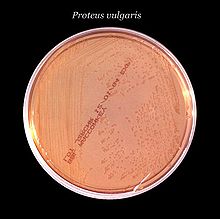
Back متقلبة شائعة Arabic متقلبه شائعه ARZ Proteus vulgaris German Proteus vulgaris Spanish Proteus vulgaris French Proteus vulgaris Galician Proteus vulgaris Italian Odmieniec pospolity Polish Proteus vulgaris Swedish
| Proteus vulgaris | |
|---|---|

| |
| 24-hour-old culture | |
| Scientific classification | |
| Domain: | Bacteria |
| Phylum: | Pseudomonadota |
| Class: | Gammaproteobacteria |
| Order: | Enterobacterales |
| Family: | Enterobacteriaceae |
| Genus: | Proteus |
| Species: | P. vulgaris
|
| Binomial name | |
| Proteus vulgaris Hauser, 1885
| |
Proteus vulgaris is a rod-shaped, nitrate-reducing, indole-positive and catalase-positive, hydrogen sulfide-producing, Gram-negative bacterium that inhabits the intestinal tracts of humans and animals. It can be found in soil, water, and fecal matter. It is grouped with the Morganellaceae and is an opportunistic pathogen of humans. It is known to cause wound infections and other species of its genera are known to cause urinary tract infections.
P. vulgaris was one of the three species Hauser isolated from putrefied meat and identified (1885).
Over the past two decades, the genus Proteus, and in particular P. vulgaris, has undergone a number of major taxonomic revisions. In 1982, P. vulgaris was separated into three biogroups on the basis of indole production. Biogroup one was indole negative and represented a new species, P. penneri, while biogroups two and three remained together as P. vulgaris.
© MMXXIII Rich X Search. We shall prevail. All rights reserved. Rich X Search